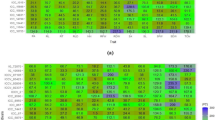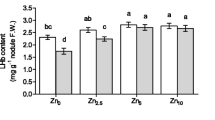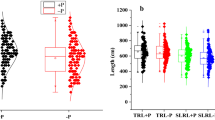Abstract
Chickpea (Cicer arietinum L.) is extensively grown in areas where soils are deficient in zinc (Zn). To determine the response of chickpea to Zn nutrition and to diagnose Zn status in plant tissue, two glasshouse experiments were conducted using Zn-deficient siliceous sandy soil. In Experiment 1, two genotypes of desi chickpea (Dooen and Tyson) were grown at five Zn levels (0, 0.04, 0.2, 1.0 and 5.0 mg kg-1 of soil). After 4 weeks, no difference in growth and no visible symptoms of Zn deficiency were detected. After 6–8 weeks of growth, chlorosis of younger leaves and stipules occured in the Zn0 treatment, with shoot dry weight being only 24% of that recorded at the highest Zn level. Root growth increased from 0.52 g/plant when no Zn was applied to 1.04 g/plant in the treatment with 0.2 mg Zn kg-1 of soil; no response to further increase of Zn fertilization occurred. Zinc concentration in the whole shoot increased significantly with increased in Zn application. The critical Zn concentration in the shoot tissue, associated with 90% of maximum growth, was 20 mg kg-1 for both genotypes at flowering stage.
In the second experiment, two genotypes of desi chickpea (Tyson and T-1587) were grown at three Zn levels (0, 0.5 and 2.5 mg kg-1 of soil) under two moisture regimes (field capacity 12% w/w, and water stress 4% w/w). Shoot growth was influenced by both Zn supply and water stress. The effect of water stress was severe in the 0.5 and 2.5 mg Zn treatments where shoot dry matter was reduced 52 and 46%, respectively. T-1587 was less sensitive to Zn deficiency and produced higher shoot dry weight than Tyson in the Zn0 treatment. Zinc concentration in shoots increased from 5 mg kg-1 when no Zn was applied to 40 mg kg-1 at the highest Zn level. The critical Zn concentration in shoots was 21 mg kg-1.
The results of the two experiments showed that the critical concentration for Zn did not differ amongst the three cultivars used and was not affected by soil moisture. Similar studies should be undertaken with a wider number of genotypes to discover if a critical concentration of 20–21 mg kg-1 in the shoot can be used to diagose the Zn status of chickpea genotypes.
Similar content being viewed by others
References
Ahlawat I P S 1990 Diagnosis and alleviation of mineral nutrient constraints in chickpea. In Chickpea in the Nineties. Eds. H A Vanrheenen and M C Saxena. pp 93–99. ICRISAT Hyderabad, India.
Bell R W, Kirk G S, Plaskett D and Loneragan J F 1990 Diagnosis of Zn deficiency in peanut (Arachis hypogaea) by plant analysis. Commun. Soil Sci. Plant Anal. 21, 273–285.
Cakmak I, Marschner H and Bengerth F 1989 Effect of Zn nutritional status on growth, protein metabolism and levels of indole-3-acetic acid and other phytohormones in bean (Phaseolus vulgaris L.). J. Exp. Bot. 40, 405–412.
Duncan O W 1967 Correction of Zn deficiency in wheat on the Darling Downs, Queensland. Queensl. J. Agric. Anim. Sci. 24, 287–292.
Graham R D, Ascher J S and Hynes S C 1992 Selecting zinc-efficient cereal genotypes for soils of low zinc status. Plant Soil 146, 241–250.
Hu H and Sparks D 1991 Zinc deficiency inhibits chlorophyll synthesis and gas exchange in "stuart’ pecan. HortSci. 26, 267–268.
Katyal J C 1985 Research achievements of all India coordinated scheme of micronutrients in soils and plants. Fert. News 30, 67–80.
Kausar M A, Alam S M, Sharif M and Pervaiz M I 1979 Micronutrient status of Pakistan soils. Pak. J. Sci. Ind. Res. 22, 156–161.
Khattak J K and Perveen S 1986 Trace element status of Pakistan soils. In Proc. of XII International Forum on Soil Taxonomy and Agrotechnology Transfer, Lahore, Pakistan. pp 119–124. Soil Survey of Pakistan and Soil Management Services, USA.
Leggett G E and Westermann D T 1986 Effects of corn, sugarbeet and fallow on Zn availability in subsequent crops. Soil Sci. Soc. Am. J. 50, 963–968.
Loneragan J F, Grunes D L, Welch R M, Aduayi E A, Tengah A, Lazar V A and Cary E E 1982 Phosphorus accumulation and toxicity in leaves in relation to zinc supply. Soil Sci. Soc. Am. J. 46, 395–352.
Marsh D B, Waters L Jr 1985 Critical deficiency and toxicity levels of tissue Zn in relation to cowpea growth and N2 fixation. J. Am. Soc. Hort. Sci. 110, 365–370.
Melsted S W, Motto H L and Peck T R 1969 Critical plant nutrient composition values useful in interpreting plant analysis data. Agron. J. 61, 17–20.
Ohki K 1975 Lower and upper critical Zn levels in relation to cotton growth and development. Physiol. Plant. 35, 96–100.
Ohki K 1977 Critical Zn level related to early growth and development of determinate soybeans. Agron. J. 69, 969–974.
Rashid A, Ullah R and Salim M 1987 Soil conditions and crop factors inducing Zn deficiency in plants. In Proc. of the National Seminar on Micronutrients in Soils and Crops, Peshawar, Pakistan. pp 94–117. NWFP Agric. Uni., Peshawar, Pakistan.
Rengel Z 1995 Carbonic anhydrase activity in leaves of wheat genotypes differing in Zn efficiency. J. Plant Physiol. 147, 251–256.
Rengel Z and Graham R D 1995 Importance of seed Zn content for wheat growth on Zn-deficient soil. I. Vegetative growth. Plant Soil 173, 259–266
Reuter D J, Cartwright B, Judson G J, McFarlane J D, Maschmedt D J and Robinson J B 1988 Trace elements in South Australia. Technical Report No. 139.
Reuter D J, Loneragan J F, Robson A D and Plaskett D 1982 Zinc in subterranean clover (Trifolium subterranean L. cv. Seaton Park). I. Effects of Zn supply on distribution of Zn and dry weight among plant parts. Aust. J. Agric. Res. 33, 989–999.
Reuter D J, Loneragan J F, Robson A D and Tranthim-Fryer D J 1983 Intraspecific variation in the external and internal Cu requirements of subterranean clover. Agron. J. 75, 45–49.
Riceman D S 1948 Mineral deficiency in plants on the soils of the Ninety-mile plain in South Australia. 5. Effect of growth and removal of a crop treated with Zn and Cu upon pasture established subsequently on Laffer sand, near Keith. J. Counc. Sci. Ind. Res., Australia 21, 229–235.
Siddique K H M and Sedgley R H 1986 Chickpea (Cicer arietinum L.), a potential grain legume for south-western Australia: Seasonal growth and yield. Aust. J. Agric. Res. 37, 245–261.
Sillanpää M and Vlek P L G 1985 Micronutrients and the agroecology of tropical and Mediterranean regions. Fert. Res. 7, 151–167.
Singh B P, Singh A P and Sakal R 1983 Differential response of crops to Zn application in calcareous soils. J. Indian Soc. Soil Sci. 31, 534–538.
Singh J P, Dahiya D J and Narwal R P 1990 Boron uptake and toxicity in wheat in relation to Zn supply. Fert. Res. 24, 105–110.
Singh R P 1990 Status of chickpea in the world. Int. Chickpea Newsl. 22, 10–16.
Tiwari K N and Dwivedi B S 1990 Response of eight winter crops to Zn fertilizer on a Typic Ustochrept soil. J. Agric. Sci. (Camb.) 115, 383–387.
Tiwari K N and Pathak A N 1982 Studies of the Zn requirements of different crops. Exp. Agric. 18, 393–398.
Wade L J and Bath S J 1985 Zinc deficiency in navy beans in the Dawson-Callide. II. Response to Zn application in the fields. Queensl. J. Agric. Anim. Sci. 42, 63–69.
Ware G O, Ohki K and Moon L C 1982 The Mitscherlich plant growth model for determining critical nutrient deficiency levels. Agron. J. 74, 88–91.
Weir R G and Holland J 1980 The residual effects of fertilizer Zn on a black earth soil from north western New South Wales. In Proc. Aust. Agron. Conf. Queensl. Coll. Agric. Lawes. Ed. I M Wood. pp 310.
Welch R M, Allaway W H, House W A and Kabota J 1991 Geographical distribution of trace elements problems. In Micronutrients in Agriculture. 2nd ed. Eds. J J Mortvedt, F R Cox, L M Shuman and R M Welch. pp 31–57. Soil Sci. Soc. Am., Madison, WI.
Wilhelm N S, Hannam R J, Branford T A, Riggs J L, Allen K and Auhl L 1993 Critical level for Zn deficiency of field-grown wheat. In Proc. 7th Aust. Agron. Conf. Adelaide. Eds. G K McDonald and W D Bellotti. pp 119–121. Aust. Soc. Agron. Parville, Victoria, Australia.
Zarcinas B A, Cartwright B and Spouncer L R 1987 Nitric acid digestion and multi-element analysis of plant material by inductively coupled plasma spectrometry. Commun. Soil Sci. Plant Anal. 18, 131–146.
Author information
Authors and Affiliations
Rights and permissions
About this article
Cite this article
Khan, H.R., McDonald, G.K. & Rengel, Z. Assessment of the Zn status of chickpea by plant analysis. Plant and Soil 198, 1–9 (1998). https://doi.org/10.1023/A:1004289710069
Issue Date:
DOI: https://doi.org/10.1023/A:1004289710069




